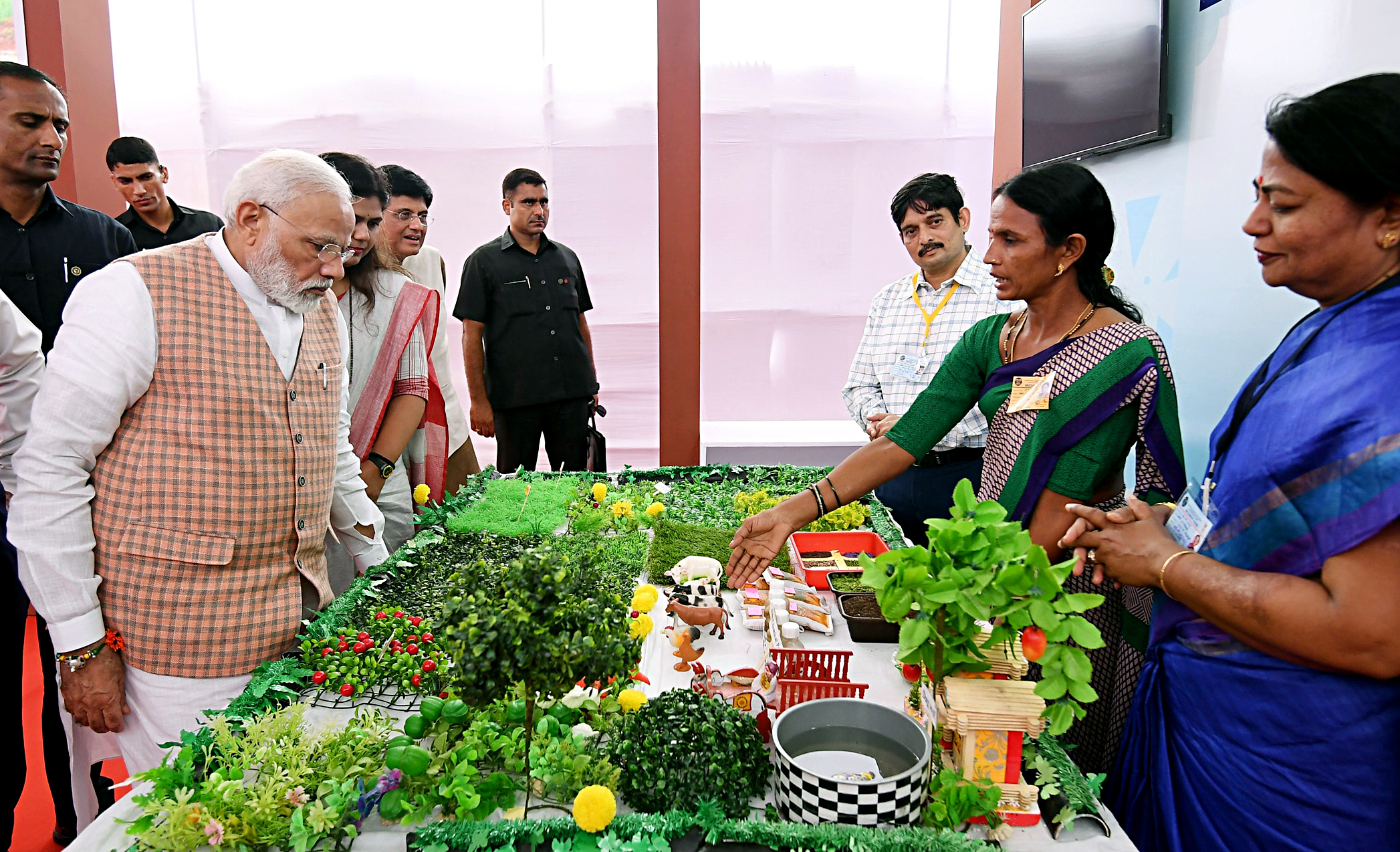An unprecedented 80 lakh Self-Help Group (SHG) members in 3 lakh villages held discussions on health and nutrition issues during their monthly meetings.
The Deendayal Antyodaya Yojana-National Rural Livelihoods Mission (DAY-NRLM), launched in 2011, aims to reach all the rural low-income families and link them to sustainable livelihoods. The main principle of this Mission is to organise the poor into Self-Help Groups (SHGs) and systematically build their capacities to improve their access to employment opportunities for income enhancement and better quality of life. As of November 2021, India has an impressive 720 lakh women as members of SHGs in 8 lakh villages across 34 states and UTs, and each day, new groups are being formed. This financial year, an amount of Rs 79,190 crore was disbursed as a loan to SHGs[1] for establishing income generation enterprises. However, a study revealed that an astounding one-sixth of loans taken by SHGs are spent on health exigencies, thus accentuating the burden of poor health in rural communities. Further, malnutrition, a root cause of poor health outcomes, continues to be rampant in the country. India is trailing at a staggering 101 out of 116 countries in the Global Hunger Report 2021, whereas our neighbouring countries have fared well. Malnutrition decreases national economic growth by 8%, while every dollar spent on reducing malnutrition generates 18 times that amount in economic benefits[2], a fact that presents a strong case for a poverty alleviation program like DAY-NRLM to contribute to this area.
It is said, “if you want to change the fruits, you must first change the roots”. However, modifying human dietary behaviour towards healthier practices takes immense perseverance and patience. The effectiveness of the SHG platform for improving core nutrition indicators was first demonstrated by the Bihar Livelihoods Promotion Society (BRLPS) that used a robust Social Behaviour Change Communication (SBCC) approach to remarkably double the child diet diversity among targeted SHG households[3]. Similarly, under a focused project, the Livelihood Missions of Chhattisgarh and Odisha could empower new mothers and pregnant women of SHG households to consume diversified diets, thus enhancing their chances of remaining healthy and delivering healthier babies[4].
Boosted by these evidence, DAY-NRLM has drafted a strategy with a carefully curated package of SBCC-based interventions targeted at vulnerable age groups. The strategy is aligned with the National Nutrition Strategy and the National Health Policy 2017 of the Government of India (GOI). Alongside SBCC, there is emphasis on social capital development, convergence with other departments to improve access to services and entitlements and promotion of enterprises that can provide livelihood opportunities, while improving local access to useful health and nutrition (HN) products, such as sanitary napkins, masks, lately sanitizers etc.
As Mahatma Gandhi said, “in a gentle way, you can shake the world”. DAY-NRLM nudges SHG members to opt for good HN practices such as consumption of micronutrient supplementation by pregnant and lactating women, institutional delivery, antenatal and postnatal care and immunisation services at Village Health, Nutrition and Sanitation Day, breastfeeding practices, a diverse and adequate diet for the young child and mother, and home-based newborn care. Food security is ensured by enrolling SHG households in the Public Distribution System and in the Take Home Ration Scheme and, most importantly, establishing a kitchen garden in every household. Non-communicable diseases, care of elderly, and care of people living with disabilities are newer areas of interest. Trained Community Resource Persons or other village level cadres conduct monthly meetings, counsel target groups and organise demonstrations in villages on balanced diet, food groups, indigenous nutritious recipes, complementary feeding techniques etc.
Last year, an unprecedented 80 lakh SHG members in 3 lakh villages held discussions on health and nutrition issues during their regular monthly meetings. In September 2021, the Poshan Maah was held in every village in which 340 lakh SHG members and their family members participated enthusiastically.
This exciting new opportunity is being accorded the highest priority by the Prime Minister’s Office, as was evidenced by the recent “call” on SHG women by the Prime Minister to contribute a few hours of their time to serving their community for better health and nutrition under Azadi Ka Amrit Mahotsav. This has created a watershed moment in the annals of India’s policy health and nutrition history.
As DAY-NRLM takes long strides ahead, it is hoped that the political will and willingness will help boost community demand for health and nutrition services, leading to better quality and coverage of service delivery systems. The commitments made at the top level must be manifested by the sustained attention from administrative and political leadership, strengthened convergence between related departments—Health, Women and Child Development, Agriculture, Animal Husbandry, etc.—and concerted efforts from partners such as practitioners, donors, researchers, academicians, not-for-profit and private sector. All these will not only help to harness the immense potential of SHG women strategically, but also will lead to the decrease of household level poverty and improve their lives and contribute to the SHG goals 1, global goals of Zero hunger and elimination of poverty.
Nita Kejrewal is Joint Secretary, Ministry of Rural Development, Government of India. Dr Amrita Misra is Director Health and Nutrition, PCI India.
Footnotes:
[1] DAY-NRLM Dashboard accessed on 21 Oct 2021
[2] Hoddinott, John F. 2013. The economic cost of malnutrition. In The road to good nutrition: A global perspective, ed. Eggersdorfer et al Chapter 5. Pp. 64-73.
[3] CARE’s Household Survey (LQAS+) data, Round 10 (Jan 2019)
[4] https://www.ennonline.net/attachments/3916/FEX-65-Web_27May-21_103-108.pdf

